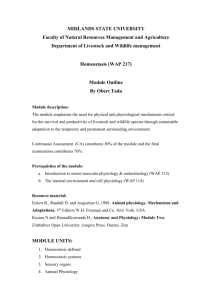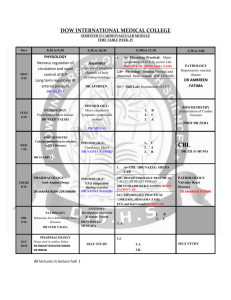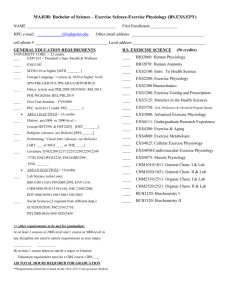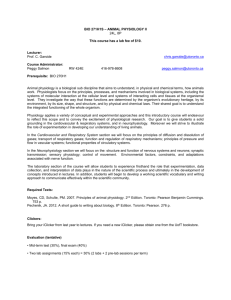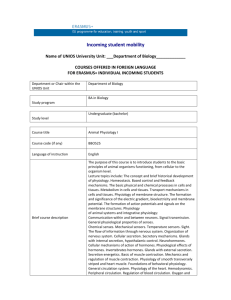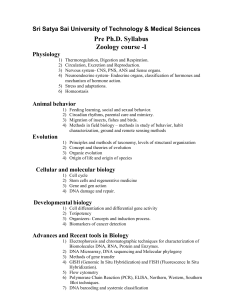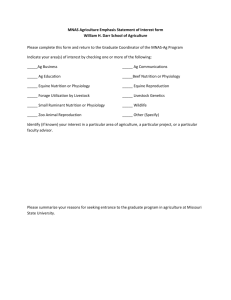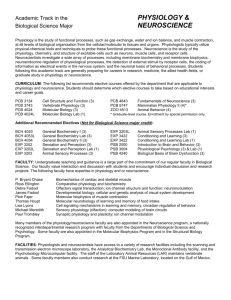Medicine - University of Tasmania
advertisement
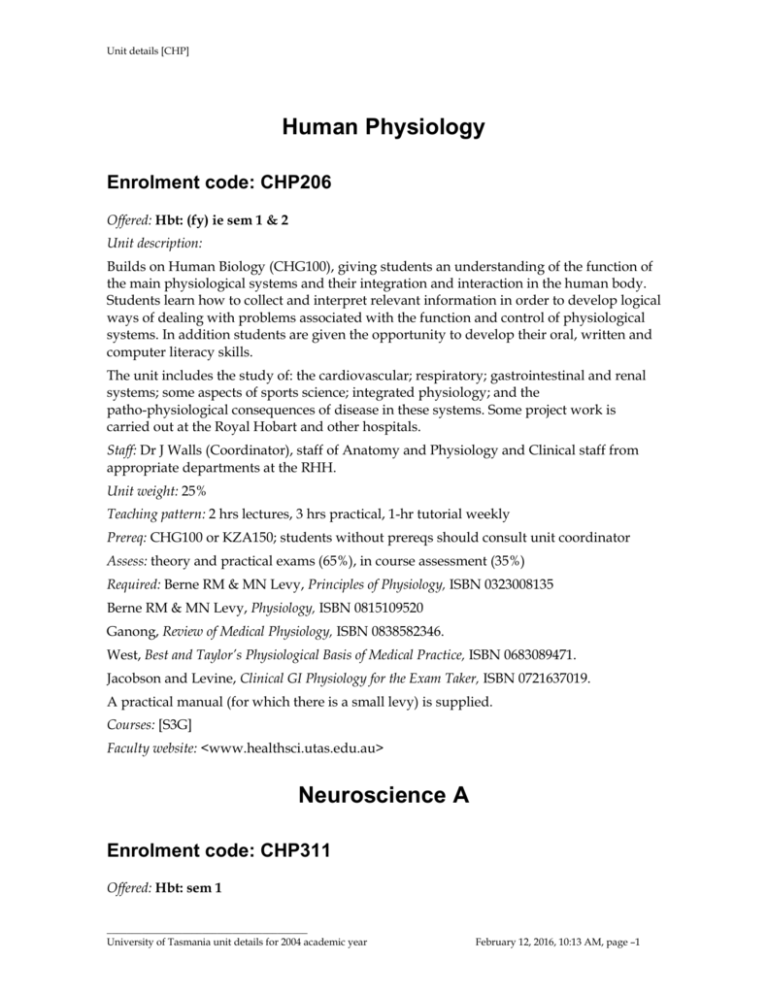
Unit details [CHP] Human Physiology Enrolment code: CHP206 Offered: Hbt: (fy) ie sem 1 & 2 Unit description: Builds on Human Biology (CHG100), giving students an understanding of the function of the main physiological systems and their integration and interaction in the human body. Students learn how to collect and interpret relevant information in order to develop logical ways of dealing with problems associated with the function and control of physiological systems. In addition students are given the opportunity to develop their oral, written and computer literacy skills. The unit includes the study of: the cardiovascular; respiratory; gastrointestinal and renal systems; some aspects of sports science; integrated physiology; and the patho-physiological consequences of disease in these systems. Some project work is carried out at the Royal Hobart and other hospitals. Staff: Dr J Walls (Coordinator), staff of Anatomy and Physiology and Clinical staff from appropriate departments at the RHH. Unit weight: 25% Teaching pattern: 2 hrs lectures, 3 hrs practical, 1-hr tutorial weekly Prereq: CHG100 or KZA150; students without prereqs should consult unit coordinator Assess: theory and practical exams (65%), in course assessment (35%) Required: Berne RM & MN Levy, Principles of Physiology, ISBN 0323008135 Berne RM & MN Levy, Physiology, ISBN 0815109520 Ganong, Review of Medical Physiology, ISBN 0838582346. West, Best and Taylor’s Physiological Basis of Medical Practice, ISBN 0683089471. Jacobson and Levine, Clinical GI Physiology for the Exam Taker, ISBN 0721637019. A practical manual (for which there is a small levy) is supplied. Courses: [S3G] Faculty website: <www.healthsci.utas.edu.au> Neuroscience A Enrolment code: CHP311 Offered: Hbt: sem 1 ________________________________________ University of Tasmania unit details for 2004 academic year February 12, 2016, 10:13 AM, page –1 Unit details [CHP] Special note: runs concurrently with CAM320 for medical students; classes commence in February one week before the rest of the University. Unit description: Provides an understanding of the integrated structure and function of the nervous system. Following introductory sections on properties of neurons, glia and synapses, the unit deals with major functional systems (for example, somatosensory system, motor system, vision and hearing and higher level processing), with emphasis on normal function and effects of pathological lesions. Opportunities for understanding applied aspects of basic neuroscience are provided by lectures on neurological disorders. The core lecture series is amplified by practical classes with both a structural and functional orientation. Staff: Dr MI Chuah (Coordinator), staff of Anatomy & Physiology Unit weight: 12.5% Teaching pattern: 75 hrs project work Prereq: (CHG100 and an appropriate level 200 unit) or CHP206 Assess: 2-hr written and 1-hr practical mid-sem test (35%), 2-hr written and 1-hr practical end-of-sem exam (65%) Required: Nolte J, The Human Brain, 5th edn, Mosby, 2001 Highly recommended: Zigmond et al, Fundamental Neuroscience, 1999 Recommend: Reference texts and atlas: Haines, Fundamental Neuroscience, 1997 Kandel ER et al, Principles of Neural Science, Elsevier, 1992 Jennes et al, Atlas of the Human Brain, Lippincott, 1995 Other appropriate material will be indicated during the year. Courses: [S3G] Faculty website: <www.healthsci.utas.edu.au> Neuroscience B Enrolment code: CHP312 Offered: Hbt: sem 2 Special note: runs concurrently with CAM320 for medical students; classes commence in February one week before the rest of the University. Unit description: Follows on directly from CHP311 Neuroscience A. The unit provides an understanding of contemporary research issues particularly in development, cell biology and molecular biology of cellular constituents of the nervous system. The unit emphasises experimental methods and techniques and the evidence on which current understanding is based. It aims to develop the students’ understanding of the nervous system and their ability to ________________________________________ University of Tasmania unit details for 2004 academic year February 12, 2016, 10:13 AM, page –2 Unit details [CHP] analyse and present experimental data as well as building on the structural and functional approach developed earlier. Teaching consists of seminar discussions, supported by practical classes and project work. A research project is an essential component of the unit; it is of a practical nature and extends for approximately 10 weeks. Staff: Dr MI Chuah (Coordinator), staff of Anatomy & Physiology Unit weight: 12.5% Teaching pattern: 75 hrs project work Prereq: CHP311 Assess: oral project report (20%), written project report (40%), review paper (40%) Required: Nolte J, The Human Brain, 5th edn, Mosby, 2001 Highly recommended: Zigmond et al, Fundamental Neuroscience, 1999 Recommend: Reference texts and atlas: Haines, Fundamental Neuroscience, 1997 Kandel ER et al, Principles of Neural Science, Elsevier, 1992 Jennes et al, Atlas of the Human Brain, Lippincott, 1995 Other appropriate material will be indicated during the year. Courses: [S3G] Faculty website: <www.healthsci.utas.edu.au> Applied Physiology Enrolment code: CHP330 Offered: Hbt: may be taken in sem 1 OR sem 2 Unit description: Provides the opportunity for students to expand their knowledge of physiology by advanced studies in particular areas. Applied aspects of respiratory, comparative and sports physiology are given particular emphasis through a series of advanced lectures and seminars supported by tutorials. Following these the students will concentrate ion one area for a major project which will include the presentation of a seminar, a written report and a literature review. Staff: Dr JT Walls (Coordinator), staff of Anatomy & Physiology Unit weight: 12.5% Teaching pattern: 3 lectures/seminars, 1 tutorial and 3-hr practical/project time weekly (13 wks) Prereq: CHP206 Assess: Project (50%), Seminar (20%) and Essays (30%) Required: either Berne RM & MN Levy, Principles of Physiology, ISBN 0323008135 ________________________________________ University of Tasmania unit details for 2004 academic year February 12, 2016, 10:13 AM, page –3 Unit details [CHP] or Ganong WF, Review of Medical Physiology, ISBN 0838582346 Johnson, Leonard R, Essential Medical Physiology, ISBN 0937584016 Courses: [S3G] Faculty website: <www.healthsci.utas.edu.au> Physiology 4 (BSc Honours) Full time/Part time Enrolment code: CHP415/416 Offered: Hbt: (fy) ie sem 1 & 2 Special note: full-time students enrol in CHP415 (100%); part-time students in CHP416 (50%) Unit description: Provides students with an experience in laboratory based research. This is achieved mainly by students working on a specific research project. With appropriate guidance from their supervisor (a member of the academic or research staff of the division), students plan, execute, interpret, analyse and communicate the results of their experimental work. Modern physiological research involves a wide range of techniques from the molecular to working with whole animals and human subjects and including a whole range of methods in cell biology, immunology, physiological system monitoring, morphological and biochemical techniques. The main areas of research within the Discipline are: developmental neurobiology, comparative physiology, respiratory physiology, human exercise physiology, molecular physiology. A successful Honours year is hard work but enjoyable for appropriately motivated students. Students are strongly advised to have detailed discussion with the prospective supervisor and other staff and students in the laboratory they are contemplating joining, before making a decision on an Honours year. Staff: Assoc Prof M Maskrey and staff of Anatomy & Physiology Unit weight: 100%/50% Teaching pattern: research project, seminar and thesis Prereq: BSc Assess: main research projects, thesis (70%), lab work during the year (10%), seminar (20%) Courses: [S4E] Faculty website: <www.healthsci.utas.edu.au> ________________________________________ University of Tasmania unit details for 2004 academic year February 12, 2016, 10:13 AM, page –4

